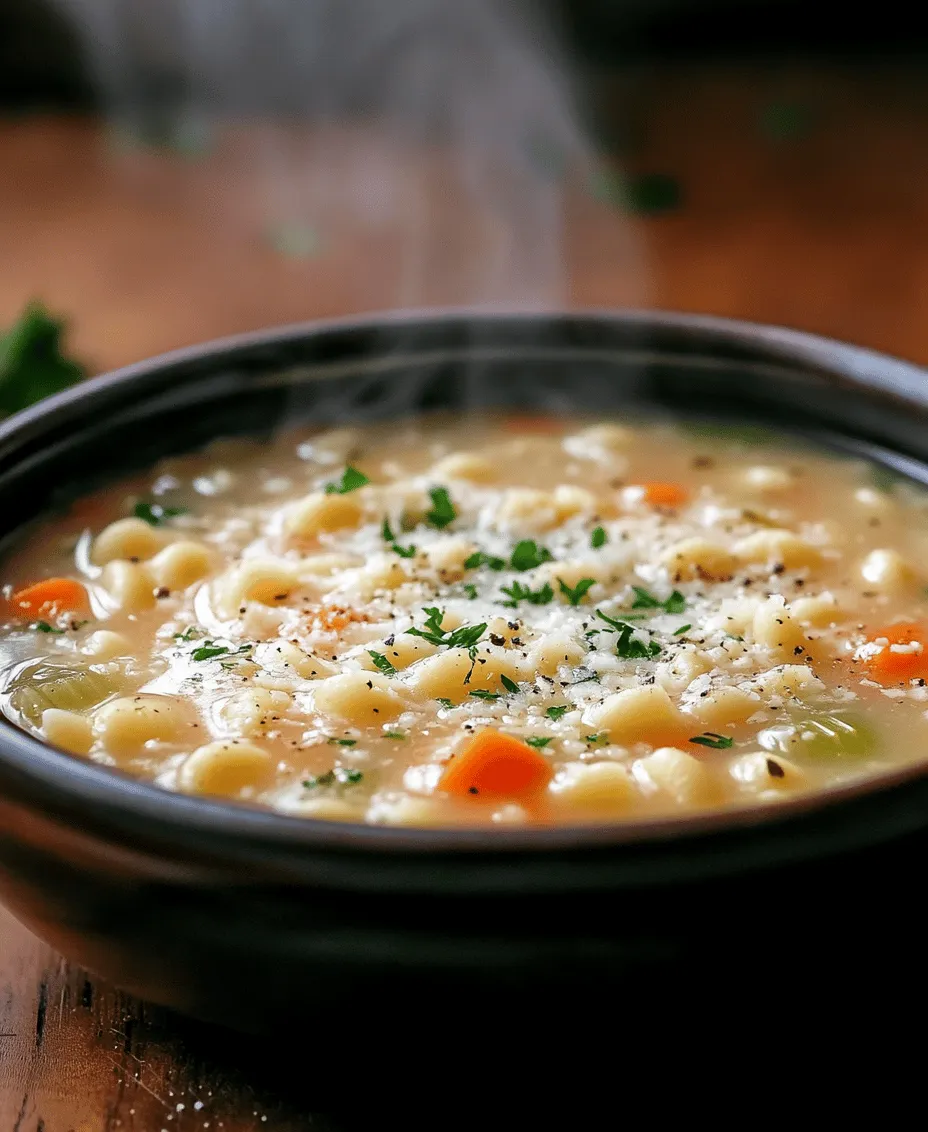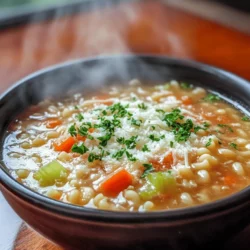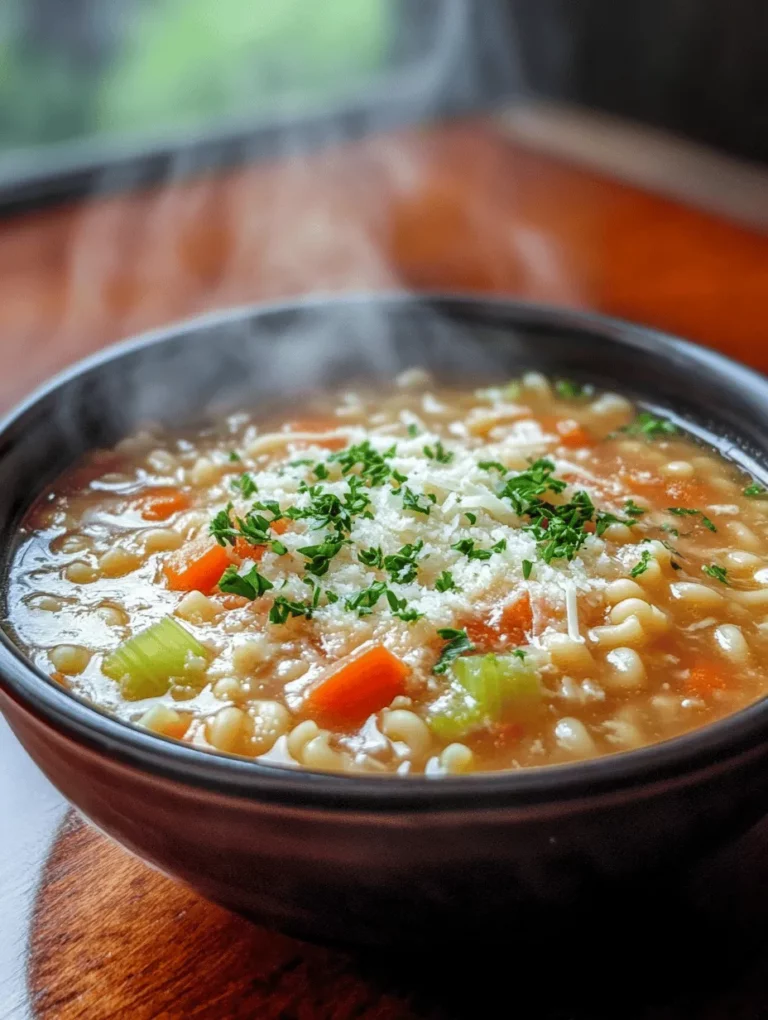Introduction
In the rich tapestry of Italian cuisine, comfort food holds a special place. Whether it’s a hearty lasagna or a delicate risotto, these dishes not only tantalize the taste buds but also evoke feelings of warmth, nostalgia, and home. Among these comforting classics lies Pastina Soup, often lovingly referred to as Italian Penicillin. This traditional remedy is much more than just a bowl of soup; it embodies the essence of nourishment, care, and the healing power of food.
Pastina, with its tiny pasta shapes, is a staple in many Italian households, especially during moments when comfort is most needed. It’s often associated with childhood memories, where mothers and grandmothers would prepare it for their little ones or for family members feeling under the weather. This soup, with its soothing broth and tender pastina, brings not only physical nourishment but also emotional solace, making it a beloved dish that many Italians cherish.
The authenticity of Pastina Soup lies in its ingredients. Utilizing fresh, high-quality components, particularly homemade broth, can elevate this simple dish into a culinary masterpiece. The flavor of the broth—rich and deeply satisfying—forms the backbone of the soup, while the pastina adds a delightful texture. In this article, we will delve into the background of Pastina Soup, explore its ingredients, and guide you through the first steps of preparing this comforting dish.
Understanding Pastina
Definition and History of Pastina
Pastina, which translates to “little pasta” in Italian, refers to various small pasta shapes that are commonly used in a plethora of Italian dishes. These tiny strands or grains are often made from durum wheat semolina and come in various forms, from the classic acini di pepe (peppercorn-sized) to tiny stars and other whimsical shapes.
The history of pastina dates back centuries, with roots in Italian peasant cooking. Historically, it was a practical choice for families, as small pasta shapes cook quickly and are incredibly versatile. They can be used in soups, salads, baked dishes, and even sweet recipes. Over time, pastina became a comfort food icon, often served in broths or combined with simple ingredients to create nourishing meals.
The Role of Pastina in Various Italian Dishes
In Italian cuisine, pastina serves as a canvas for flavors, easily absorbing the essence of the dishes it accompanies. Beyond Pastina Soup, it can be found in risottos, pasta salads, and as a side dish to enhance a variety of meals. Its small size makes it an excellent choice for feeding children or those recovering from illness, as it is easy to chew and digest.
Pastina is not just a one-dimensional ingredient; its adaptability allows for creativity in the kitchen. It can be flavored with herbs, tossed with vegetables, or incorporated into casseroles. From simple broths to complex sauces, pastina can be the star of the show or a humble supporting player.
Nutritional Benefits of Small Pasta Shapes
Small pasta shapes like acini di pepe offer more than just a comforting texture; they also bring nutritional benefits. Made primarily from whole grains, pastina is a source of carbohydrates that provide energy and sustenance. When paired with nourishing broth and vegetables, pastina transforms into a balanced meal, rich in vitamins and minerals.
Moreover, the lightness of pastina makes it an excellent option for those seeking a gluten-friendly alternative. When made from alternative flours such as rice or quinoa, pastina can accommodate various dietary needs, making it a versatile ingredient in modern cooking.
The Comfort of Soup: A Cultural Perspective
The Cultural Significance of Soup in Different Cuisines
Soup has long been a staple in cuisines around the world, often regarded as a source of comfort and healing. In Italian culture, soup plays a prominent role, serving as a fundamental dish during family gatherings and celebrations. It is not uncommon for Italian families to gather around a steaming pot of soup, sharing stories and laughter, as the aroma fills the air.
In Italy, soups vary widely by region, with each area boasting its unique ingredients and preparation methods. From the rich minestrone of the north to the light broths of the south, soups reflect the local culture and climate. Pastina Soup, with its simplicity and heartiness, exemplifies the Italian tradition of using humble ingredients to create a dish that resonates deeply with the soul.
The Idea of “Food as Medicine” in Italian Culture
The concept of “food as medicine” is ingrained in Italian culture, where the act of cooking is often seen as an expression of love and care. When someone falls ill or feels down, a warm bowl of soup is frequently the remedy of choice, believed to offer both physical and emotional healing. Pastina Soup, in particular, is associated with nurturing and is frequently prepared for children experiencing illness or for adults seeking comfort.
Stories abound in Italian families of mothers and grandmothers who would take to the kitchen, simmering rich broths filled with pastina and fresh vegetables. This practice not only provided nourishment but also conveyed warmth and affection, reinforcing the bond between family members.
These cherished memories are woven into the fabric of Italian culture, where food is a vehicle for connection, care, and healing. As you prepare Pastina Soup, you’re not just making a meal; you’re participating in a long-standing tradition that celebrates the power of food to comfort and restore.
Ingredient Breakdown
Pastina: Types and Cooking Tips
When it comes to making Pastina Soup, the type of pastina you choose is crucial. Acini di pepe is a popular choice due to its small, round shape, but other varieties like stelline (star-shaped) or orzo (rice-shaped) can also be used.
Cooking pastina is a straightforward process, but there are a few tips to keep in mind:
1. Cooking Time: Since pastina is small, it cooks quickly—typically within 3 to 5 minutes. Be sure to check the package instructions for precise cooking times to avoid overcooking.
2. Adding to Soup: To prevent the pasta from becoming mushy, consider cooking it separately and then adding it to the soup just before serving. This way, the pastina maintains its texture and doesn’t absorb too much broth.
3. Portion Control: Keep in mind that pastina expands while cooking, so a little goes a long way. For a single serving, about 1/4 cup of dry pastina is usually sufficient.
Broth: Importance of Homemade vs. Store-Bought
The broth is the cornerstone of any good soup, and for Pastina Soup, the choice between homemade and store-bought is significant. Homemade broth, made by simmering bones, vegetables, and herbs, imparts a depth of flavor that is unmatched by store-bought varieties. It allows for customization based on personal taste and dietary preferences.
1. Flavor Building: When making your broth, consider adding aromatics like onions, garlic, carrots, and herbs to create a rich base. The longer you simmer the broth, the more flavorful it will become.
2. Storage: Homemade broth can be made in large batches and stored in the freezer for future use. This makes it convenient to have on hand for spontaneous soup cravings.
3. Store-Bought Convenience: If time is of the essence, high-quality store-bought broth can still yield a delicious soup. Look for low-sodium options with natural ingredients to ensure a wholesome flavor.
Vegetables: Nutritional Benefits of Onion, Garlic, Carrots, and Celery
The vegetable medley in Pastina Soup adds both flavor and nutrition. A classic mirepoix of onions, garlic, carrots, and celery forms the aromatic base of the soup, providing essential vitamins and minerals.
– Onion: Rich in antioxidants and known for its anti-inflammatory properties, onions enhance the soup’s sweetness and depth of flavor.
– Garlic: Renowned for its immune-boosting qualities, garlic adds a pungent aroma and a distinctive taste that elevates the broth.
– Carrots: Packed with beta-carotene, fiber, and vitamins, carrots lend a natural sweetness to the soup and add a lovely color.
– Celery: Low in calories but high in essential nutrients, celery contributes a crunchy texture and subtle flavor that complements the other vegetables.
These vegetables not only enrich the flavor of Pastina Soup but also pack a nutritional punch, making the dish a healthy choice for all ages.
Herbs and Spices: The Role of Bay Leaf and Thyme in Enhancing Flavor
Herbs and spices play a crucial role in elevating the flavor of Pastina Soup. Simple yet effective, the addition of bay leaves and thyme can make a significant difference in the overall taste profile.
– Bay Leaf: Often used in soups and stews, bay leaves impart a subtle earthy flavor that enhances the broth. Remember to remove the bay leaves before serving, as they are not meant to be eaten.
– Thyme: This aromatic herb brings a warm, earthy flavor that pairs beautifully with the other ingredients. Fresh thyme is preferred, but dried thyme can also be used if fresh is unavailable.
Utilizing fresh herbs not only enhances the flavor but also adds vibrant color and aroma to the soup. A sprinkle of fresh parsley or basil just before serving can provide a bright finish to your Pastina Soup.
Parmesan Cheese: Flavor Profile and Its Role in Italian Cuisine
No Italian dish is complete without a generous grating of Parmesan cheese. This hard cheese, known for its rich umami flavor, adds a luxurious touch to Pastina Soup.
1. Flavor Enhancement: Parmesan cheese enhances the soup’s flavor, providing a salty richness that balances the sweetness of the vegetables.
2. Nutritional Benefits: Packed with protein and calcium, Parmesan cheese contributes to the nutritional profile of the dish, making it more satisfying.
3. Serving Suggestion: Serve Pastina Soup with freshly grated Parmesan on top, allowing each bowl to be customized based on personal preference.
Olive Oil: Health Benefits and Use in Italian Cooking
Olive oil is a cornerstone of Italian cooking, celebrated for its health benefits and rich flavor. When making Pastina Soup, a drizzle of high-quality extra virgin olive oil can enhance the dish in several ways:
1. Flavor Depth: Olive oil adds a fruity, peppery flavor that complements the other ingredients in the soup.
2. Health Benefits: Rich in monounsaturated fats and antioxidants, olive oil supports heart health and has anti-inflammatory properties.
3. Cooking Medium: Use olive oil as the base for sautéing your vegetables. Start with a few tablespoons in the pot before adding onions and garlic to build a flavorful foundation for the soup.
Tips for Sourcing High-Quality Ingredients
The quality of the ingredients used in Pastina Soup directly impacts the final result. Here are some tips for sourcing the best components:
1. Local Markets: Whenever possible, shop at local farmers’ markets for fresh, seasonal vegetables and herbs. This not only supports local farmers but ensures you’re using the freshest ingredients available.
2. Organic Options: Opt for organic vegetables and grains to minimize exposure to pesticides and chemicals, enhancing both flavor and health benefits.
3. Artisan Products: For ingredients like Parmesan cheese and olive oil, seek out artisanal producers. Look for products labeled as PDO (Protected Designation of Origin) for authenticity.
4. Store-Bought Alternatives: If sourcing fresh ingredients proves challenging, choose high-quality store-bought options that prioritize natural ingredients. Check labels to avoid additives and preservatives.
By focusing on fresh, high-quality ingredients, you can create a bowl of Pastina Soup that is not only delicious but also nourishing and comforting.
As we move forward, we will guide you through a step-by-step process to make your own Italian Penicillin: Pastina Soup, ensuring that every bowl reflects the love and tradition embedded in this timeless dish.
 chicken) and bring it to a gentle boil. Lower the heat to a simmer and allow the flavors to meld for about 20-30 minutes. As the soup simmers, the ingredients release their flavors, creating a warm and inviting broth. This extended cooking time also helps to soften the vegetables while retaining their vibrant colors—look for a radiant orange hue from the carrots and a bright green from the celery.
chicken) and bring it to a gentle boil. Lower the heat to a simmer and allow the flavors to meld for about 20-30 minutes. As the soup simmers, the ingredients release their flavors, creating a warm and inviting broth. This extended cooking time also helps to soften the vegetables while retaining their vibrant colors—look for a radiant orange hue from the carrots and a bright green from the celery.
Cooking Pastina
Cooking pastina requires precision to achieve the perfect al dente texture. After the soup has simmered for the designated time, add the pastina to the pot. It will only need about 5-7 minutes to cook, so keep a close eye on it. Stir occasionally to prevent the tiny pasta from sticking to the bottom of the pot. The secret to perfect pastina is to taste it a minute or two before the package instructions suggest; it should be firm yet tender when bitten into.
Incorporating Cheese and Seasoning
Towards the end of the cooking process, it’s time to enhance your soup’s flavor profile. Grate a generous amount of Parmigiano-Reggiano cheese and stir it into the soup. The cheese not only adds richness but also thickens the broth slightly. Season with freshly cracked black pepper and a pinch of salt, tasting as you go to ensure a balanced flavor. The cheese should melt seamlessly, creating a velvety texture that complements the soft pastina and tender vegetables.
Serving Suggestions
To elevate your Pastina Soup, consider these garnishing ideas and pairing options.
Garnishing the Soup
Chop fresh parsley and sprinkle it generously on top of each bowl before serving. This adds a pop of color and a fresh herbal note that brightens the dish. For a bit of extra indulgence, consider adding a dollop of pesto or a drizzle of high-quality olive oil just before serving—these additions introduce layers of flavor that enhance the overall experience.
Pairing Options
Pastina Soup can be enjoyed as a starter or as a main dish, depending on your serving size. If you opt for it as a main course, pair it with a simple side salad, perhaps dressed with lemon vinaigrette, to balance the richness of the soup. For a heartier meal, crusty bread or garlic bread can be served alongside, perfect for dipping into the warm broth.
Health Benefits of Pastina Soup
Not only is Pastina Soup comforting, but it’s also packed with nutritional benefits.
Nutritional Analysis
This soup is low in calories yet high in nutrients. With the inclusion of fresh vegetables, it provides essential vitamins and minerals. Carrots are high in beta-carotene, which is great for eye health, while celery provides hydration and fiber. The addition of cheese contributes calcium and protein, making this dish a wholesome option.
Comfort Food and Well-Being
Comfort food plays a vital role in mental well-being. The warmth of a bowl of Pastina Soup can evoke feelings of nostalgia and happiness, often reminding us of family gatherings and shared meals. The act of cooking and enjoying food with loved ones can enhance emotional health, providing a sense of connection and comfort.
Dietary Variations
For those with dietary restrictions, Pastina Soup can be easily customized. To make it vegetarian, ensure that you use vegetable broth. For a gluten-free option, substitute the pastina with gluten-free pasta or rice. You can still enjoy the rich flavors and textures without deviating from your dietary needs.
Variations and Customizations
Exploring variations of Pastina Soup can keep your meals exciting.
Regional Variations
In Italy, Pastina Soup can vary significantly by region. In Naples, you might find it with a tomato base, while in Tuscany, the addition of cannellini beans is common. Consider experimenting with these variations to suit your taste.
Adding Proteins
If you wish to transform your soup into a heartier meal, consider adding proteins such as shredded rotisserie chicken or cooked beans. This not only enriches the soup but also adds a satisfying texture. Simply stir in the protein of your choice during the last few minutes of cooking to heat through.
Creative Twists
Incorporating seasonal vegetables is another way to customize your Pastina Soup. For example, in the spring, add asparagus or peas for a fresh touch. In autumn, consider adding diced butternut squash for a hint of sweetness. Additionally, spices such as a pinch of red pepper flakes or a dash of smoked paprika can introduce a new dimension of flavor.
Conclusion
Italian Penicillin: Pastina Soup is a timeless dish that embodies the essence of comfort food. Its rich history and cultural significance remind us of the importance of family traditions and shared meals. As you embrace the process of homemade cooking, remember that the joy it brings to your table is immeasurable.
Whether served as a remedy for a chilly day or as a starter at a family gathering, Pastina Soup is sure to warm hearts and bellies alike. So grab your ingredients, invite your loved ones to the kitchen, and enjoy the delightful journey of making and sharing this beloved Italian classic.

